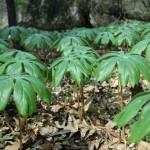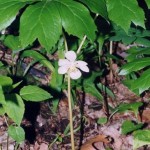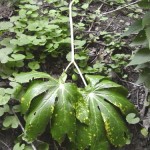Mayapple Root – Podophyllum peltatum
|
Current Demand = Normal |
Parts Used: Root |
 |
 |
 |
 |
Family: Berberidaceae
Common names: Mayapple, Devil’s Apple, Hog-apple, Indian Apple, American Mandrake, American May Apple, Racoonberry, Wild Lemon…
Description:
Mayapple is a perennial native herb found in moist soils and rich woods in Eastern North American to the Rocky Mountains. Mayapple grows to about 18 inches, the stem separates into two large, dark green, long stemmed, palmate, lobed leaves. It looks similar to an umbrella to protect the white flowers.
The flowers are 2 inches in diameter bloom in spring later turning into a crab apple size fruit. May-apple roots are dark brown, fibrous and jointed. The May-apple root creeps horizontally and can be up to 6 feet in length. It is flexible, smooth, and round, dark brown on the outside and whitish and fleshly within. It can have stem scars on the lower side can have tuft rather stout roots.
Part Used: root
Planting/Cultivation:
Growing region: Mayapple is found in the Eastern United States and Canada. It is very common thru-out the Midwest south to Florida and west to Texas and north to Minnesota. Large populations exist in Kentucky, Illinois, Indiana, Ohio, Tennessee and West Virginia. It is often found in rich moist woods and in upper portions of timber areas. Only partial shade is required for Mayapple to thrive and large patches can be found in clearings. Mayapple is one of the first plants to come up in the spring.
The May-apple prefers a rich well drained, moist soil and partial to deep shade. It can be found in fields, roadsides, rich woods, thickets, and pastures.
Mayapple is easy using to grow using seedling transplants or seed sown in fall. This plant is easy to start from rhizomes and adapts well to new situations. The seeds are distributed to new locations in the feces of animals.
Harvest/Drying:
For maximum potency gather the roots in late September or October, after the seed has matured. The root is the most poisonous part of the plant and should never be ingested for self medication. The Mayapple has a long skinny root system which can grow several feet in length. The root grows fairly shallow to the ground surface and is often able to be harvested quickly by hand in softer soil. Gather the larger more mature plants leaving plenty of younger plants to seed the area for future harvest.
After harvest, the roots should be washed in cold water and foreign material (leaves, rocks, dirt, and other foreign roots) must be removed. Unless your buyer is purchasing fresh dug roots (which they often do) the clean roots need to be dried. Mayapple root hold a great deal of moisture. It is not uncommon for wild ginger root to dry 7:1 meaning it could take as much as seven pounds of fresh root to make one pound of dry root.
Mayapple can be dried in the sun although if possible dry indoors in a well ventilated barn loft or attic to protect from the elements. If natural heat is not available you may need to add heat to a room and a fan for continuous airflow. Make sure your roots are dry prior to storage as it tends to be susceptible to mold.
The key to drying any root herb or bark is an even combination of heat and airflow. Never dry in an over or microwave.
Roots are completely dry (largest root will snap not bend), in approximately 3-8 days depending on the size of the roots and the drying conditions. Place the dried roots carefully into a cardboard box or paper bag for storage in a dry area until you are ready to sell or use. Do not store the root in plastic or it will mold.
Attributes (Images)
By Valis55 (Own work) [CC BY 3.0], via Wikimedia Commons
 Root Buyer
Root Buyer